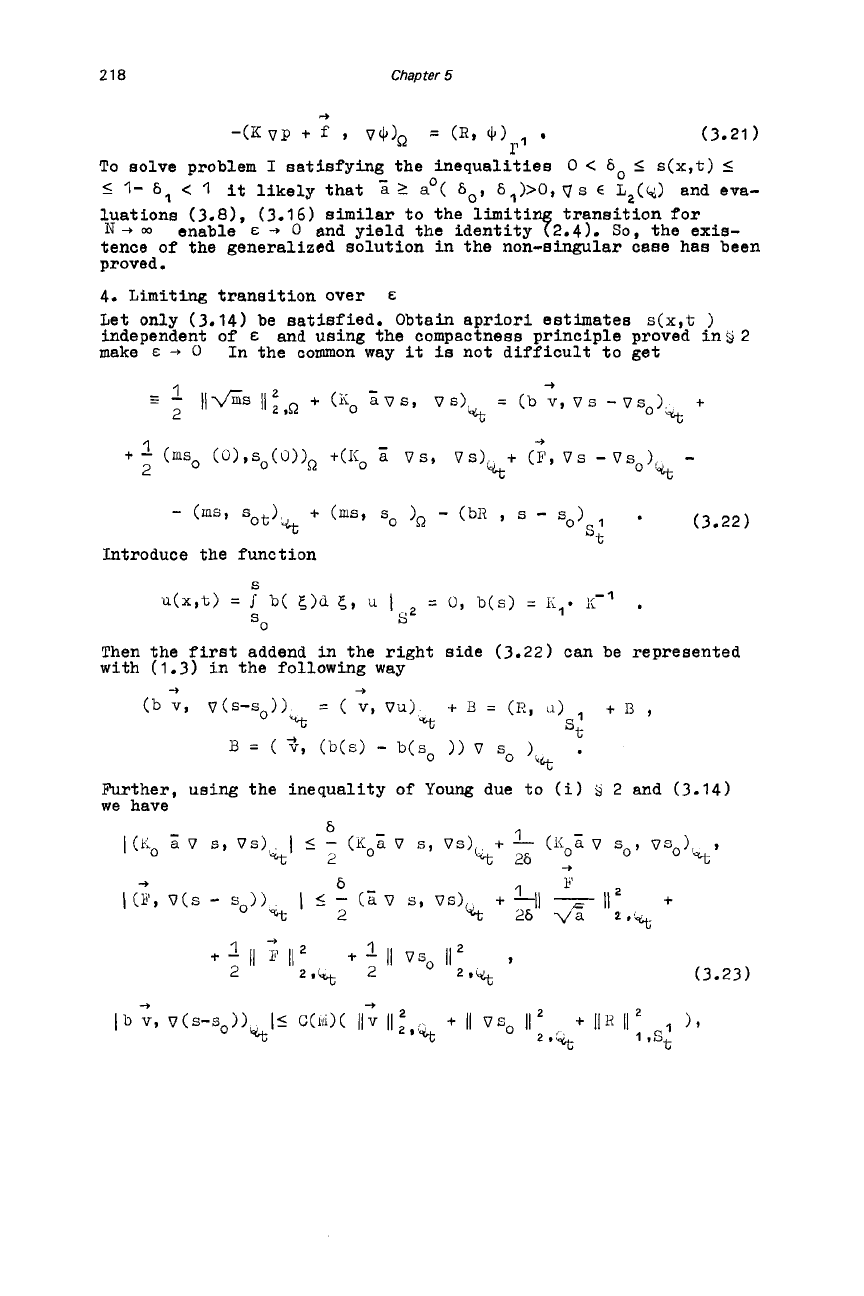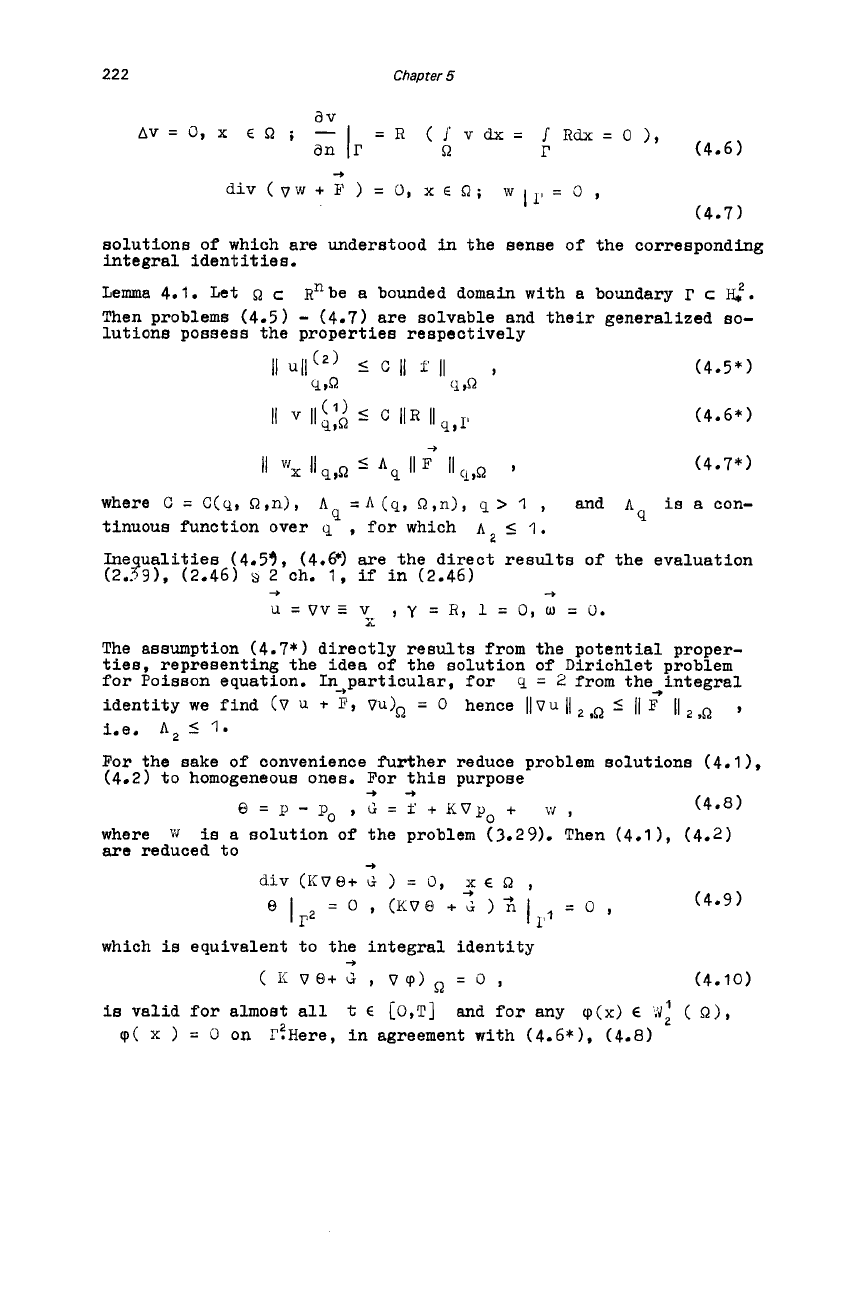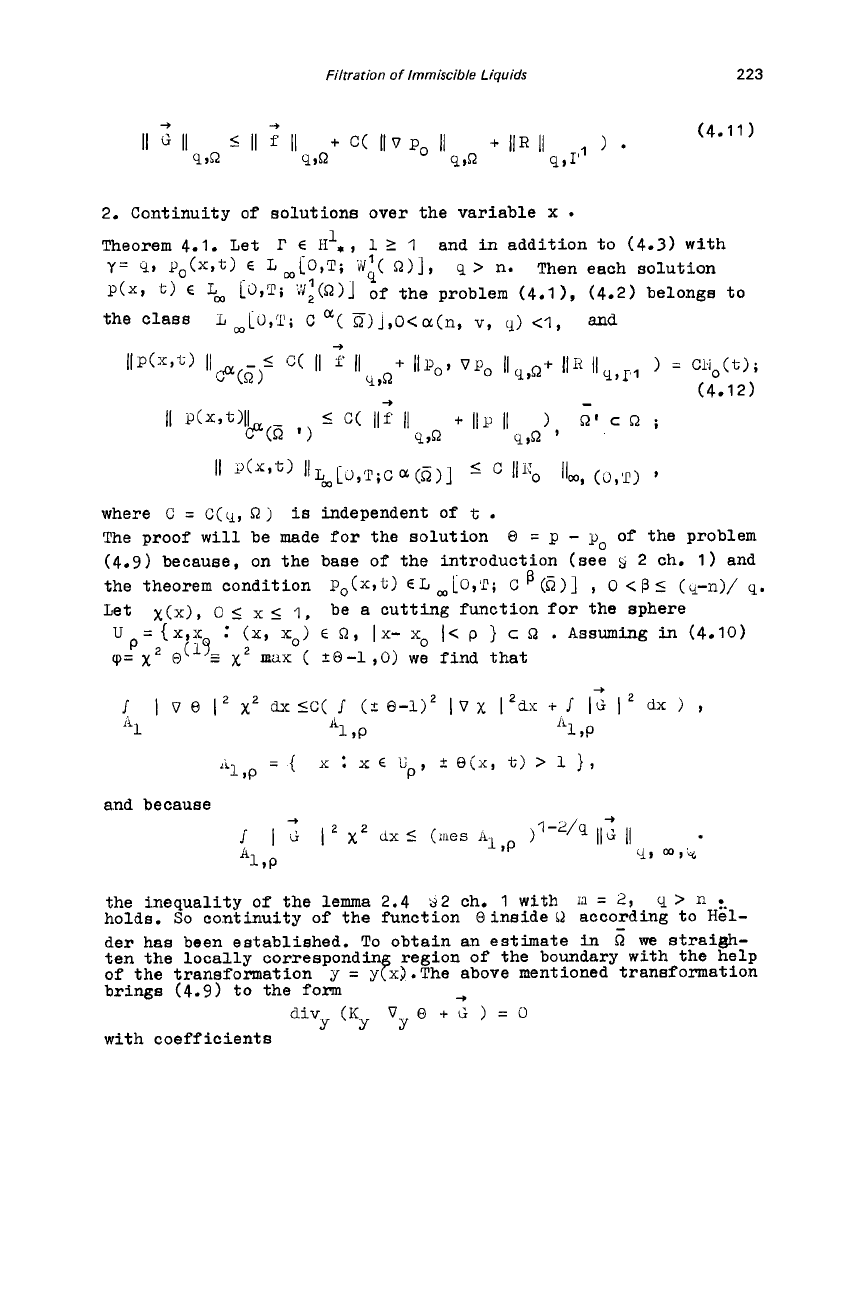Antontsev S.N., Kazhikhov A.V., Monakhov V.N. Boundary Value Problems in Mechanics of Nonhomogeneous Fluids
Подождите немного. Документ загружается.


218
Chapter
5
-3
-(KVP
+
f
9
V+),
=
(R,
$1
(3.21)
To
solve problem
I
satisfying the inequalities
0
<
bo
I
s(x,t)
5
5
1-
6,
<
1
it
likely that
a
2
a’(
hO,
6,)>0,
V
s
E
L2(%)
and eva-
luations
(3.81,
(3.16)
similar
to the
limiti
transition for
N
+
m
tence
of
the generalized solution in the non-singular case has been
proved.
4. Limiting transition over
E
Let only
(3.14)
be satisfied. Obtain apriori estimates
s(x,t
)
independent of
E
and
using the compactness principle proved in52
make
E
-+
0
In the common way
it
is
not difficult
to
get
1’
enable
E
-3
0
and yield the identityy2.4).
So,
the exis-
Then the
first
addend
in
the right side (3.22) can be represented
with (1.3) in the following way
-3
+
(b
vs
V(S-so)j
=
(
V,
VU)
+
B
=
(I?,
uj
,
+
13
,
St
4.t
’Lt
13
=
(
%,
(b(s)
-
b(s0
1)
V
S,
)
.
‘Lt
Further,
using
the inequality
of
Young due to
(i)
5
2
and
(3.14)
we have

Filtration
of
Immiscible Liquids
219
On the other hand due
to
(3.22)
-
11
s
11
+
[Id
a
v
3
11
5
C(Ld2
2
,Q
%
and besides, in accordance with (2.1)
1
E'
/
v'
5
I
5
i,io
(ii)
.
-
+
(3.24)
(3.25)
Uniting (3.23)
-
(3.25) under the corresponding choice
of
6
we
obtain with the estimate (3.8) the inequalities
Thus the
s
'(x,t)
satisfies evaluations (3.141,
(3.261,
(3.27)
uniformly over
E
and for
any
cp(x,t)
cp(x,T)
=
0
,
(3.20) holds
Here
a
w
R
*=
bR,
x
E
I?'
;
-
(mes
r2)
J"
bRdx,
x
E
I'2
}
r'
With (2.23)
S
2
ch.
1
(a
=
1)
it
is
obvious that
E
hence
11
w
11
,a
5
C
(IR
I(
So
in agreement with the theorem 2.2
(on compactness) from the se-
quence
signation) converging almost everywhere in
Q
on
S2
and another
therefore with (3.27)
1(B
11
,~
5c(d
'1,
r'l
sE
one can choose the subsequence (we keep the same de-

220
Chapter
5
N
SE
one on which
V
zE
=Vj
ko,(g)xko2
(
5)
d
5
L2(y)
to
V
z.
As
it
has been mentioned above
3'
will
converge
strongly in
L
(q)
following way:'
weakly convergent
in
N
0
on this sequence. Now we rewrite
(3.20)
in the
--t+
2XsE
,P,
cp)
5
-(ms
',
cp,)%
+(KO
a
VsE
-
b
v
+
F,
Vcpl
+
Qt
4
Here
b,
a
convergent almost
weakly.
But
with
(3.27)
everywhere and
a
VS
converge
4.
DETEFMINATION
OF
THE
SUMtED
VELOCITY
OF
INHOMOGENEOUS
LIQUID
FILTRATION
1.
The statement of problem
As
it
has been mentioned in
38
1
problems on determining field
sum-
med velocity of inhomogeneous liquid filtration
%=
-(Kv
p
+
?
)
(see
1.4)
and
phase saturation distribution
si(x,t),
i
=
1,2
,
in some cases may be solved independently. But even
in
the cases,
when these problems do not split,
in
the processes
of
numerical
simulation of multiphaae filtration an iteration method of sequen-
tial determination of
$(x,
t)
for the given
si(x,t)
is
used
and vice versa.
The present paragraph
is
devoted to the investigation
of
a
inhomo-
geneous liquid filtration problem for the given phase saturation
distribution
si(x,
t)
and for the given reduced saturation
fied,
%(x,t)
are determined generally independent of
s(x,
b).
Substitution
of
s(x,
t>
in the coefficients of the equation
(1.8)
yields the following boundary problem for a linear elliptic equa-
div(Kvp+f)=O,xEQ,
(4.1)
s(x,
t), (x,t)
E
%.
In
particular,
if
conditions
3b
1
are satis-
tion
-3
--t
in which
K,
f,
p,,R
x
E
Q
and the parameter
t
E
[O,
T
3.
In
case when
1'
=
1"
assume that
are the given functions
of
the variable
we

Filtration
of
Immiscible Liauids
22
1
1
p(x,
t)
dx
=
R(x,
t)
dx
=
0,
t
E
[0,
T]
.
(4.2*)
R
r
As
it
was shown in
S3,
the problem
(4.11,
(4.2)
has
a
generalized
solution
the integral identity and the
first
condition
(2)
p(x,t)
E
L,
i0,T;
i"l;(Q)
U
L,
(a)],
which for all
2
t
E
[O,T]
and random
q(x)
E
id;@),
q(x)=O,
x
E
r
satisfies
The functions of the variables
(x,t)
EQ,
i<
=
{kij},
f,po
,
B
are assumed with
s(x,t),
0
5
S
5
1
sess the properties:
substituted
i.n
them to pos-
For
a
generalized solution
P(x,t)
tion (see
(3.81,
(3.26)
1
in
b
3
there exists an evalua-
-t
5
C(ll
f
II
+(I
IPo
1+1
VPo
111
+
IIR
I/Y,m,S1)'
2,
m,k
=9
m,it
z,m,,
II
V
.P
II
(4.4)
from which follows the uniqueness of linear problem solutions
(4.11,
(4.2)
in the class
We investigate the further smoothness
of
the solution
Definition
4.1.
The boundary
I?
of
the bounded multiconnected do-
main
D
belongs to the class
12
,
12
1,
if
1
)
in the vicinity of each point
x
meomorphic transformation
Lm
[a,
T;
,vz(
a>].
p(x,t>
E
E
L
mLu~'f;~~~(D>]
with respect to the given data.
I"
17
I"
there exists a ho-
1
y(x)=
(y,(x>,
x2(x),
y,(x))
E
C
,
such that
pq2
-
1
M
D(x>
y3(~'i
=
o
,
y,(
Q>
>
o
,
i
=
1,2
,
i.e.
2)
in the vicinity of each point
formation
neighbour
of
the edge (vertex)
of
a cube in variables
y
.
Now
prove
p(x,
t)
over
x
and mumability
vp
with the degree
Y
>
2.
Note, that the last property
p(x,
t-)
is
essentially used
when investigating the joint problem on the homogeneous liquid
filtration. Solution properties of the following boundary problems
will
be used firther for the Laplace and Poisson equations (see
93,
144
and
Y
2
ch.
1)
I?'
can be locally straightened.
x
E
I"
17
I?'
there exists a trans-
Y
=
y(x>
with the same properties mapping
it
at the
Au
=f,x
EQ;ulr=0
(I?=aR>,
(4.5
1

222
Chapter
5
+
div
(vw
+
1'
)
=
0,
x
E
a;
w
11,
=
0
,
solutions
of
which
are
understood in the
sense
of
the
corresponding
integral identities.
Lemma 4.1. Let
Q
c
Rnbe
a
bounded domain with a boundary
r
c
$.
Then problems (4.5)
-
(4.7) are solvable and their generalized
so-
lutions possess the properties respectively
(4.7)
where
C
=
C(q,
Q,n),
hq
=A
(y,
P,n),
q
>
1
,
and
hy
is
a
con-
tinuous function over
(1
,
for
which
A,
5
1.
he ualities (4.59, (4.6*)
are
the direct results of
the
evaluation
(2.391, (2.46)
Y
2
ch.
1,
if
in (2.46)
3 3
U
=VVS
v
,
y
=
R,
1
=
0,
w
=
9.
P
The assumption (4.7*) directly results from the potential proper-
ties, representing the idea of the solution of Dirichlet problem
for Poisson equation. h+particular,
for
q
=
2 from the+integral
identity we find
(V
u
+
F,
VU)a
=
0
hence
IIVU((,,~
5
(IF
112,Q
,
i.e.
A,
5
1-
(4.2) to homogeneous ones.
@="-Po
9
where
w
is
a
solution
of
are
reduced to
div
(Kv'8+
IF'
=
which
is
equivalent to the
+
(
K
vf3+
G
is
valid for almost
all
t
For
the sake of convenience further reduce problem solutions (4.1
1,
For
this purpose
3+
ii
=
f
+
KVp
vi,
(4.8)
the problem (3.29). Then (4.11, (4.2)
+
ii)=O,
XEQ,
(4.9)
+
11,1
=
O
3
,
(KV8
+
i
)
"n
integral identity
8
VCP),
=
9
I
E
[O,T]
and
for any
q(x)
E
:d:
(
Q),
(4.10)
cp(
x
1
=
9
on r?Here, in agreement with (4.6*),
(4.8)

Filtration
of
Immiscible
Liquids
223
2.
Continuity
of
solutions over the variable
x
1
Theorem
4.1.
Let
P
E
I1
*,
1
L
1
and
in
addition to (4.3) with
Y=
Y.9
P,(X,G)
E
L
,COPT;
vi'(
Q)1,
P(X,
6)
E
L,
I~PT;
:!:(a)]
of
the problem (4.11, (4.2) belongs to
the class
LmtO,T';
C
"(
C)J,O<a(n,
v,
q)
<I,
and
q
>
n.
Then each solution
cl
Ilm,
(3,Ip)
'
where
C
=
C(L~,
Q
j
is
independent of
t
.
The proof
will
be made
for
the solution
Q
=
p
-
po
of
the problem
(4.9) because,
on
the base of the introduction (see
5.
2
ch.
1)
and
the theorem condition
P,(X,G)
EL
,[o,l';
C
'(cs?l>]
,
0
<P5
(q-n),'
q.
Let
~(x),
0
5
5
1,
be a cutting function for the aphere
U
=
{X,X
:
(x,
x,)
E
Q,
Ix-
X,
I<
p
}
c
B
.
Assuming
in
(4.10)
P
cp=
x2
0(l9s
x2
rnax
(
ZQ-1,O)
we find that
+
1
)Vf3~2X2dx5C(1 (+~-l~z~vx12~~+~lG12~~
,
'il
'5
,P
"1
tP
=
{
x
:
XE
lJ
,
+0(x,
t)
>
1
},
"1
rP
P
and because
the inequality of the lemma
2.4
32
ch.
1
with
12
=
2,
q
>
n
holds.
So
continuity of the function
0
inside
$2
according to
Hk'l-
der has been eetablished.
To
obtain
an
estimate
in
n
we
straigh-
ten the locally correspondin region of the boundary with the help
of the transformation
y
=
yfxJ.
The above mentioned transformation
brings (4.9) to the
form
+
div
(Ky
V
8
+
G
)
=
0
Y
Y
with coefficients

224
Chapter
5
-D
and
is
likely to keep the properties
K,
Continue the whole
problem beyFd the boundary in the following way.
In
Y(It2):
8
by
even,
K,G
by odd; in
y(r'):
O,iC,
Gl,G2
by even,
G3
by
odd.
It's
easy
to
see that under such continuations
6
satisfies
again the identity analogous to (4.10) but in
a
wider region
Q*
Now one can consider tke
for
a
continuous function
G*
-3
9
P*
II
*
I1
then finally
spheres transversing
Up
and since
the inequality
is
valid
-3
sCII3;l
*
Y
,Q
The latter with (4.11)
in view proves the theorem completely.
Remark
1.
The above mentioned continuity of the solution beyond the
boundary for which almost
all
evaluations in
5
become internal
wil.
will
be frequently used in further studies. One must note that this
continuity in
a
mixed problem
is
possible due to the assumption
2,
in
to.
3.
Solutions belonging to the class
"J1(
Q),
9
>2.
Theorem 4.2. Let the matrix Ir(x,t)in addition to conditions
of
the
theorem 4.1 with
q
>n
satisfies the condition (i)
1:
=iCo(x)
k,(x,t)
where the matrix
Ko(x)
E
C(
i)
and
k(x,t)
is
a
mesurable func-
tion for
Ik(x,t)
-11
5
6
<
I.
class
L,
[O,T;
$il
(~)Jand for almost
all
t
E
[O,TJ
the inequa-
lities hold
the definition of the
class
,
1
I
1
to which belongs
r
9
Then any solution
2(x,t)
E
LmLO,
I;
it;(
Q)
1
of
the problem (4.11, (4.2) belongs to the
90
Here
is
chosen from the inequality
ti%,
C
are defined in the theorem (4.1) and
%,
2
<yo
5
Y,
0

Filtration
of
Immiscible
Liquids
225
where
We’ll begin to prove the theorem again for the function
At
first
let
inequality (4.15)
and
take the finite number
of
infinitely
diffe-
rential positive finite functions
tions where
O1
not outnumber
E
chosen from the condition
is
a constant in the inequality (4.7*).
90
@(x,t).
r2=
I’
.
Fix the number
yo,
2
<s,
5
9,
satisfying
X1(x>
a
-
,X,(X>
and the func-
xl=
1,
x
E
Q;
Let the diameter
of
their supports
N
-
c
1
(4.16)
A
(
6
+
max
I
K,(x>-
K
(y)
1)
5
A,
<
I
.
0
40
Ix-*
E
satisfying respectively the problems
(4.18)
--t
div(K
V
el+
Gl
)
=
0,
x
E
sll
;
=
0,
x
E
aQ1
,
+
+-
where
C;
-
ti
-
K
0.
V
x1
-
V
v
and
v
is
a solution
of
the problem
l-
x1
--t
(4.5) with
i
=
K
V@VX1
+
G
VXL
.
If
the support
in
p
by the method described in the proof
of
the theorem
4.1.
Wther let
tion
Qlof
independent variables reducing a constant positively de-
fined matrix Ko(xl> to the unity
ji.
Having the same symbols we
will
consider the given transformations to have been done.
Now
01
can be assumed as being finite outside
51
satisfying
(4.18).
The
problem
(4.+18)
will+
take the followid
form:
v
@-,.(K~-
x)k-(
I-k)
v
01
1,
where
li
is
a
unity matrix.
In
accordance with the lemma
4.1
there
exists
a
solution
of
the
last
problem for which the evaluation
Fs
valid
Qlonly partially belongs to
Q
then we continue
0
xle
Q~
be a fixed point. Make
an
affine transfoma-
div(
v
o1
+
G;>=
0,
ti;
=
(<
+
considering
(4.16)
-+
Then applying (4.5) with
q=2
find that
(4.19)

226
Chapter
5
Due to (4.17)
v
8
=
c
Pi
N
1
1
(
0
x1
1
=
c
v
01,
v
O1
=
0,
x
$
Q1
,
that’s why, summing (4.19) over
1
yields
from which with (4.11) in view we finally find
+
IIH
llqypl
*
For the internal eethite
it
is
likely enough to get inequality
(4.19) for
O=
p,
3
=
f
cinity of
r
With the help of the continuity deacribed in theorem
4.1
r
=rl
u
estimates
in
Q
one can integrate the received inequalities over
t
E
[o,
11.
-
Remark
2.
As
one can see from the proof,
if
l;(x,t)
EC(,)
the num-
ber
(&,
in
the theorem may be taken randomly from half-interval
(1,
Q
The second condition in the definition
of
class
to
which belongs
is
an
essential one.
Remark
3.
The proved theorem for
%>n
provides the solution
and one function
X
(x)
finite in the vi-
rz
is
reduced to the case considered.
TO
obtain
i,(x,t>
of
the problem (4.1), (4.2) belonging to the space
C
for almoat allt
€
[O,T],O
<
CL
<(yo-
n)
/
%
which
is
in agreement to the imbedding theory (see lemma 2.1
y
2,
ch.
1).
In the plane case
(n
=
2)
always
~1
<%
<
q
and consequently,
but
in
the space
case to prove the solution over
x
(in
accordance with eummability
of
the degree
>
5)
one must demand, that in addition to the
condition
9
>3
the fluctuation
i;(x,t)
would satisfy inequality
(4.15) for
%
=
j
i.e. there would be
6A3<
1
*
(4.20)
p(x,t)E
LmLC),l;
C
CL(Q>],
0
<
CL
<
($-
2)/
cb
4.
Estimates of higher derivatives of a solution

Filtration
of
Immiscible Liouids
227
where all
norme
Fn
the right side
of
the inequality have been
taken over
Q
and
C
is
independent
of
t.
If
in addition
(
%a>,
Di
R
E
Lq(
S’>
dl+l
x
Po
Lhl,q
1.
(Dx
h
means derivatives over
r
then
(4.22)
1+1
1
II
v
9
Ilhll a6
5
c(
li3+
lIu:+’’
Po
lIhl,~+
/IDx
R
11
I),
491’
where
Q6
=
{
x
:
x
E
Q,
The
proof
will
be makde first for
a
strongly internal Bubdomain
Q’.
Introduce functions
An
1
x -
y.
I
2
6
>
0
}
y
E
r1
nr2
1
P(X+
h,t)
-
P(X,
t>i,
(X,X
+h)
E
Q’
,
1
Ph
=
-
Ih
I
satisfying the equation
-t
div
(K
vph
+
Kh
‘Jp
+
fh
=
3
(4.23)
For which
the theorem
4.2
and remark
2
ph
EL,
[i),T;
iil(a)]
and consequently in accordance with
+
11
vph
ll),l,Ql
{
IIi‘hV1’
Ilhl,
+
11
‘h
lIAl,~II
+
+
IIFh
Q
}
9
a’
c
Q”
c
Q
Applying the theorem
4.2
again for evaluation
of
the firet and the
last addend8 we obtain
